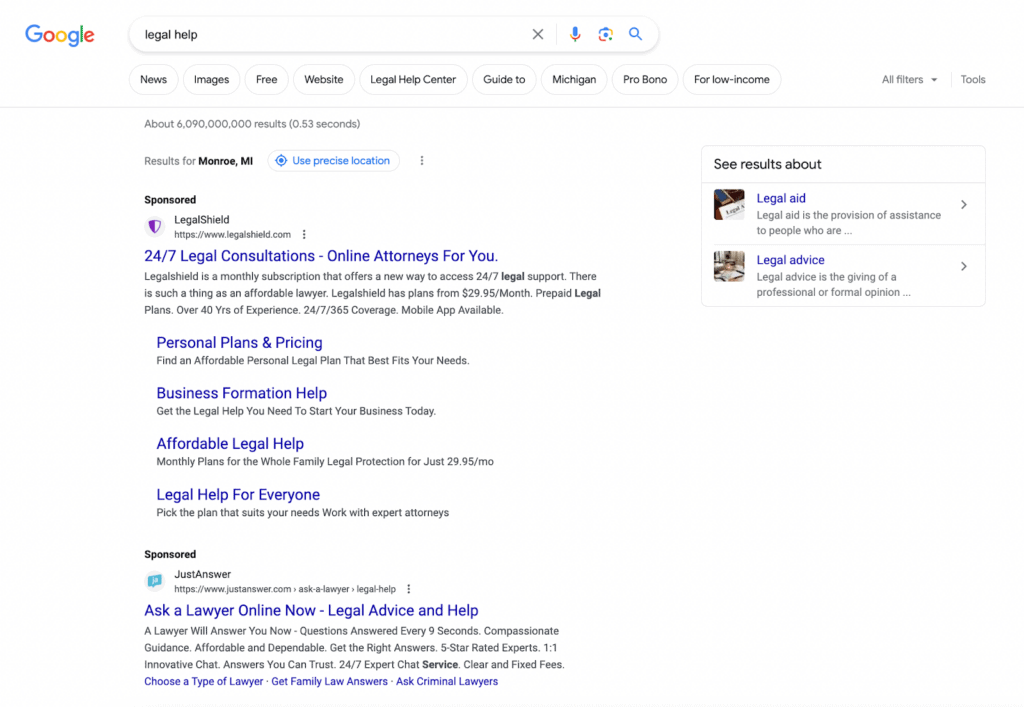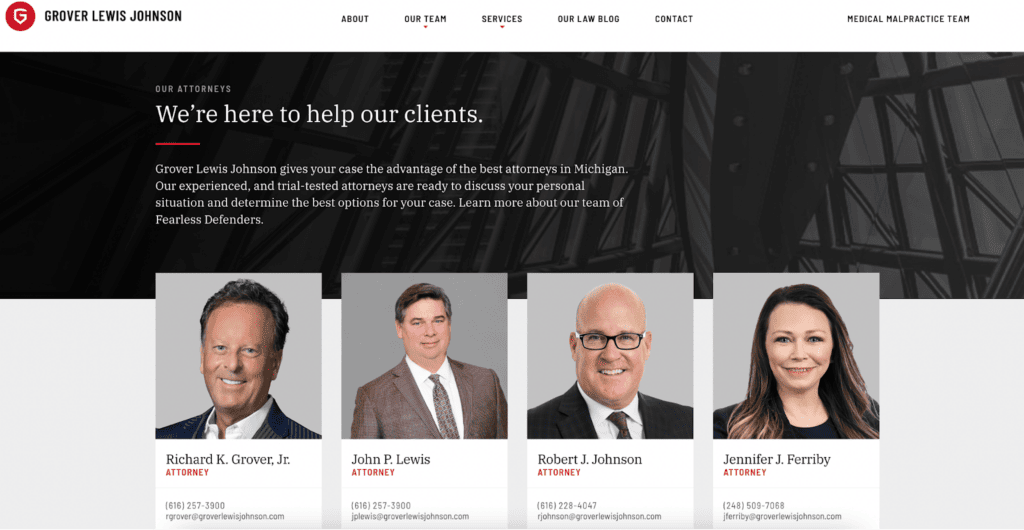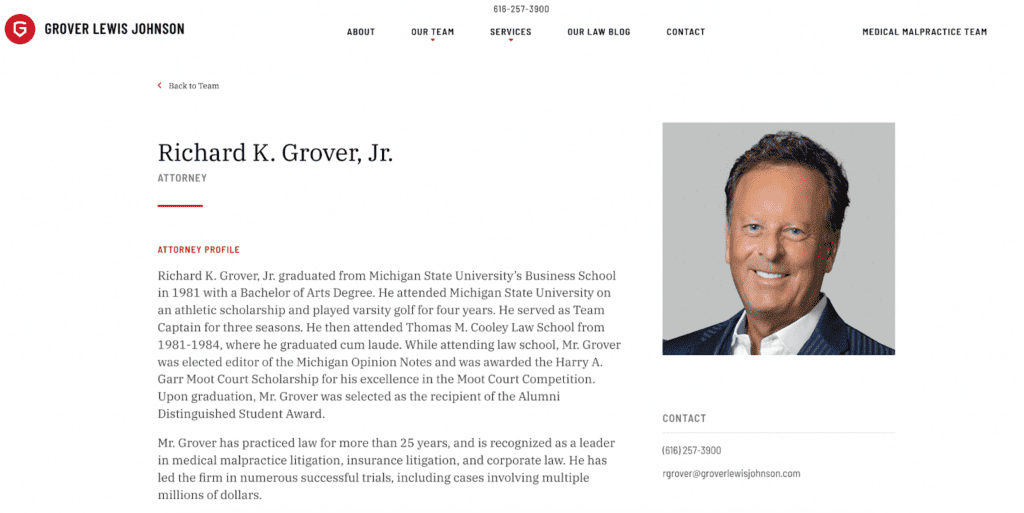What's in this article?
Welcome to our ultimate legal marketing guide—your comprehensive resource for navigating the complex world of legal marketing.
A strong digital marketing presence is crucial for law firms and attorneys to connect with their target audiences.
This framework is the actual template that we start with when we design a strategy for a new legal client.
We use this framework as a mental model to ensure that we have all of the proven best practices. We bake Kaleidico’s 15 years of experience into every new client’s legal marketing strategy.
Leverage this legal marketing guide to help build your unique digital strategy. Whether you’re a seasoned legal professional or a newly established firm, everyone can use a refresher.
By the end of this guide, you’ll be able boost your visibility and generate high-quality case leads.
See how Kaleidico can help you reach lead generation goals and get the best cases.
Legal marketing business objective(s)
Any new strategy has to begin with your ideal outcomes.
What are you expecting to accomplish in your legal marketing? What do you need to complete to consider the system a success?
For most law firms, the highest level answer to these questions is often, “We need to generate new cases from the website.”
As you drill deeper, you’ll probably uncover additional motivations, such as:
- The desire for a more sophisticated or refined online brand
- The desire for a more modern and updated look to the website
- A shift in practice areas and case focus
- A better presentation of partners and attorneys online
- A better mobile experience (You would be shocked at the number of attorneys that hate their seemingly good website because they only see it through their iPad or mobile phone, and that experience is atrocious)
In this section of our digital plan, we’re trying to determine and document the following:
- Why is digital marketing important to the law firm?
- What are their key performance expectations?
- What do they expect to get from this sales and marketing strategy when it works?
This section should contain clear performance expectations.
Key drivers of new business
From this point, it’s crucial to determine what’s generating cases today.
Many of today’s cases can be attributed to a law firm’s website, which may be surprising considering the user experiences on these websites are often frustrating and confusing.
However, its status as a key driver despite these obstacles leaves plenty of potential for a major boost in traffic once a neglected website has been updated, redesigned, and optimized.
The following are the typical leading drivers of new case inquiries in order of frequency and potential case volume.
1. Informational searches
A web search is often the first step for individuals who are facing legal issues or seeking legal advice about a particular case type.
Generally, these individuals are plaintiffs and defendants who are trying to make an early assessment of their situation to determine if they “have a case.”
They may know very little about the process, so they turn to a search engine such as Google to search for keywords such as “how to find a good lawyer,” “lawyers near me,” or “legal help/advice following a car accident/divorce/etc.”
If you have high-quality content on your website that contains these keywords, you can attract these clients and meet them where they are on their journey.
Search engine optimization (SEO) strategies including keyword research can help you target the right clients and draw them to your website so you can collect the lead.
2. Professional referrals
Professional referrals from others in the legal industry, such as lawyers from different practice areas, can be a significant source of new case inquiries.
Referrals come from building strong professional relationships and networking with other attorneys inside and outside of your firm.
If you have a working relationship with an attorney and they come across a case in your area of expertise, they’ll likely refer the client to you based on your professional connection with them.
The key to successful referral partnerships comes both from those strong, genuine working relationships as well as your firm providing excellent legal services and maintaining a positive reputation within the legal community.
To start building these relationships, reach out to other firms or consider hosting a networking event for local professionals. You also can start by using a social media platform such as LinkedIn.
3. Attorney visibility
How will people find you if you aren’t anywhere to be found?
Attorney visibility includes both a strong online and offline presence among the communities you represent locally and professionally.
Offline, your visibility involves networking via community and professional events, public speaking opportunities, your appearance on local radio or TV interviews, publication of your articles, awards you’ve won, or case results.
Online, visibility involves maintaining an updated website filled with relevant, informative content, an active social media presence, online advertising, and profiles on online lawyer directories.
A combination of your online and offline presence is what will guarantee a steady stream of high-quality leads.
4. Case results
A portfolio of successful outcomes for clients and positive case results will significantly influence your amount of new case inquiries.
As you know, word-of-mouth is a powerful strategy. But you also need to have a way to push the word out about your successes via PR and media visibility.
Consider also displaying client testimonials or case studies on your website that highlight your track record for achieving favorable results for clients.
Client testimonials are a powerful source of potential leads. When other people can see that your firm successfully handled similar cases or achieved notable settlements, they will be much more willing to reach out for a consultation on their legal issues.
Our digital strategy will seek to leverage each of these sources of cases and make the user experience frictionless to ensure that these case inquiries make it to the law firm’s attorneys.
Digital asset inventory
Now that we know what the law firm wants from digital legal marketing, and we’ve confirmed what drives their business today, we only have one more area of research to conduct.
What raw materials do we have to start? Which digital assets can we leverage to build our refined sales and marketing strategy?
We often look for the following digital assets within a law firm.
Website
A law firm’s website is its primary digital asset and online presence.
Consider it your digital office space, because it’s more and more frequently going to be the place where your potential clients meet you first. In other words, it has to make a great first impression.
A law firm’s current website usually has some relevant web traffic coming from searching for the name of the law firm or a few select attorneys at the firm.
That’s a great start, but we’ll also need to consider what happens once they land on your website.
Your website should be well-designed, user-friendly, and mobile-optimized so it immediately draws visitors in and clearly directs them to where they need to go.
It should contain the following elements:
- Bold, attractive home page with your positioning statement (more on this later), a photo or graphic, a navigation bar, and clear call-to-action (CTA) buttons
- Navigation links that direct the visitor to an about page, a contact page, the firm’s practice areas and attorney profiles, a blog page, and any other resources
- SEO techniques to attract organic traffic and improve your website’s visibility in search engine results such as copy featuring keywords you’d like to target
- Contact forms, lead magnets, chat features, or client intake forms to generate leads
Take a look at Grover Lewis Johnson’s website below, which features a strong positioning statement placed over a photo, clear CTAs (“How can we help?” and “Learn more”), and navigation links to an about page, their team, and more.
The design is simple and attractive and incorporates the firm’s preferred color and font choices.

Content
Law firms that work with us initially may not have much content yet, or their existing content may need a refresh.
Your content strategy includes any written or visual materials that you have created to educate and inform your target audience.
Content includes:
- Blog posts/articles
- Videos
- Infographics
- Case studies
- Podcasts
- Legal guides
Some of this content can be used as a lead magnet, which is a valuable piece of content that you offer on your website in exchange for a visitor’s email or other contact information.
Other examples of lead magnets include ebooks, checklists, quizzes, a video series, or in-depth guides or case studies.
Content can often be repurposed, and part of your strategy includes both brainstorming content as well as scheduling it and breaking it down for other formats.
For example, a blog post can be turned into a video, and a webinar or podcast episode can be broken into several pieces of content such as videos, blog posts, and infographics.
Above all else, the content you create must be thoughtful, informative, and relevant to your firm’s practice areas and your audience’s needs. By publishing content consistently, you build up your firm as a reliable authority in your field.
This, in turn, boosts your ranking on search engines, as long as you are also incorporating relevant keywords and other SEO practices such as tags and internal/external links.
Download Our Ultimate Legal Marketing Guide
Legal directory listings
The most popular online legal directories today include FindLaw, Lawyers.com, and Avvo.
These online platforms list law firms and attorneys based on their location, practice areas, and other criteria.
To make the most of your listings, fill them out as completely as possible and make sure all your listings are up-to-date, and include relevant keywords.
Google Business Profile
Along the same lines as an online legal directory, your Google Business Profile is a free tool that allows you to control your business information and how it appears across Google’s services, such as Search, Maps, and Reviews.
Filling out your profile completely will help users find you, and give them the information and the confidence they need to reach out.
Your Google Business Profile includes the following information:
- Address
- Hours
- Phone number
- Services
- Details
- Photos
- Reviews
- Website or appointment links
According to GoGulf, 46% of all Google searches are looking for local information.
Your Google Business Profile creates a local connection that will boost your firm in searches.
The first step to creating your profile is claiming your business by logging into Google, and then verifying it. From there, you can fill in the information completely.
Among the most important pieces of your profile, if not the most important, is the reviews section.
Following a case with a successful outcome, you can ask satisfied clients to leave you a review online so you can reach others in similar situations.
You no doubt have collected emails throughout your career, so we will want to see what platform you’re using to store contact information and how you’re using it.
Attorney contact databases, which often are linked to their email client (i.e. Microsoft Outlook), can be rich with digital marketing opportunities.
A good client relationship manager (CRM) can help streamline your services and improve your customer service with data-driven decisions.
The key is to choose a platform that can integrate seamlessly with your existing systems and is robust enough to handle all your case information.
Once you have the right systems in place, you can execute an email marketing strategy to communicate with clients, prospects, and referral partners.
Examples of email marketing for attorneys:
- Regular newsletter filled with industry news, legal topics, case studies, and regulation changes
- Invitations to seminars or workshops
- Holiday or birthday greetings
- Client surveys or feedback
- Email series covering legal topics
- Case updates
Email marketing can serve many purposes, depending on your goals. Your email list should be segmented into several groups of target audiences that would benefit from each type of content you’d like to share.
For example, a previous client may receive your monthly newsletter or holiday greetings so you stay in mind for a future case or referral to friends or family.
A potential client who has downloaded a lead magnet from your website may benefit from receiving invites to upcoming webinars and your email series on relevant legal topics.
Email marketing is ideal for lead nurturing, which is a strategy used to build relationships through valuable content at various stages of the client’s journey.
As an attorney, it’s important to understand both law firm advertising rules and email marketing rules, including obtaining proper consent from clients, respecting privacy laws, and providing an unsubscribe option.
Social media
Attorneys are finding success on social media by posting informative content as well as showcasing a more relatable side of themselves.
Marketing and social media trends, in general, have shifted to make room for more authenticity and a greater human element, rather than posts that come from a firm and have no name attached.
Some lawyers have been finding success on TikTok in particular because legal topics remain relatively untapped on the platform.
Other popular platforms for lawyers include Facebook, YouTube, Instagram, and LinkedIn, depending on the firm’s target audiences and practice areas.
Social media offers firms the opportunity to engage with their target audience and build brand visibility by sharing helpful, valuable content that addresses their challenges and needs.
Examples of social media content include:
- Informational videos, such as general legal tips
- Infographics that break down complex topics
- Surveys or quizzes to better understand your audience
- Answers to frequently asked questions
- Blog posts or industry news and an explanation of how it affects your audience
- Fun, engaging posts, such as “pizza Fridays” or a family vacation photo
While there’s some debate over the use of social media in Big Law, most attorneys agree that social media is a great way to communicate information about legal services—as long as it’s used responsibly and the firm’s ultimate goals remain at the forefront.
And, of course, whether individual attorneys choose to maintain a social media presence or you enlist one of your lawyers to manage the firm’s page, make sure to give your content enough of a personalized boost to appeal to today’s audiences.
In auditing each of these areas, we’re looking to discover platforms to gather and nurture audiences around—audiences that can turn into sustainable sources for new case leads.
Audience development & traffic generation for legal marketing
Now that we have a good insight into what the law firm wants to do, what it has done in the past, and the platforms and data available to support a new strategy, it’s time to build that legal marketing strategy.
Our process begins with audience development. We need to “stock the pond” with people that need our services or will provide referrals.
Positioning statement
Our starting point should be an agreed-upon positioning statement. A clear message that defines where we fit into the market—who we serve and why.
The most basic formula for a position statement includes:
- What do we do? This is our target market need
- How do we do it? This is our differentiation strategy
- Who do we do it for? This is our target market
- Why do we do it? This is our reason to believe we’re different from our competitors
This can come together in a short positioning statement template:
For [target market] who [target market need], [brand name] provides [what we do and how we do it — differentiated value statement] because [why we do it — a reason to believe we’re different].
With a clear understanding of who we need to be talking to and how we need to be sharing our unique value proposition, it’s time to design our lead generation plan.
Legal marketing channels & tactics
Using our positioning statement, our lead generation guide is designed using this framework:
- Where does our audience get their information?
- What kind of information will they need to make a decision?
- How and through what means will they engage an attorney?
For a law firm, the answers to these questions guide our marketing channels and tactics.
Where your audience gets their information
First, let’s discuss where your clients are getting their information. These specific channels are the top places your leads are headed when they have a specific search intent.
Google Search
Your target audience is searching for legal information on Google Search and other search engines by typing in certain keywords such as “legal help,” “lawyers near me,” or even “how to sue for [incident].”
To make sure your content on these topics reaches your target audience’s eyes, you would attract them using SEO and paid ads.
SEO involves keyword research and optimizing your headings, tags, and URLs to include relevant keywords. It also includes backlinking reputable sources.
Your SEO strategy should extend into every corner of your website. To provide more opportunities for optimized content, create practice areas and case-type landing pages, and keyword-targeted blog content.
While organic traffic is essential to your strategy, the best marketing strategies have a combination of paid and organic content.

Using Google Ads, when your targets perform a search for a specific keyword or phrase on Google, your paid ads appear as “sponsored” content as in the example above.
Google Ads is based on search intent, which allows for highly targeted advertising. The cost depends on factors such as keyword competition and ad quality and operates as a pay-per-click (PPC) model.
Social media ads
Depending on your audience’s preferences and demographics, many will find you by scrolling on their favorite social media platform — especially if they have recently performed a search for legal services.
You can run ads on any of your preferred social media platforms, including Facebook, Instagram, YouTube, and LinkedIn.
Facebook ads allow you to target certain audience demographics, interests, and behaviors in a range of formats, including videos, photos, and carousels.
Instagram is owned by Meta, which also owns Facebook, so it has similar advertising options. Advertising on Instagram vs. Facebook really boils down to your target audience demographics.
As a professional networking platform, advertising on LinkedIn may be best suited for targeting industry professionals for employment or networking opportunities.
YouTube offers many advertising options, including skippable and non-skippable video ads, bumper ads, display ads, and in-feed ads that can target certain topics, interests, demographics, keywords, and more.
It ultimately comes down to where your audience is hanging out, and the types of content they prefer.
Referrals
Your referrals are searching for you, too. They’re using similar methods to those who just perform an initial Google search.
The difference is what they’re searching for on these channels.
Rather than performing a general “lawyers near me” search, they’ll search for your name or any other information provided by your referral partners.
To target this group of leads, you’ll use more specific keywords and phrases via Google Ads and SEO, such as your law firm name, attorney names, location, and practice areas.
On your website, you’ll create attorney profile landing pages and include the keywords you are targeting. Take a look at the examples below of a team landing page and a specific attorney profile landing page.


Information your audience needs to make a decision
Now that you understand the channels your audience uses to find you, we can dig deeper into what information your audience needs to make a decision—and how you can make that information easy to get.
We can present this information via website landing pages.
Practice area and case type landing pages
Practice area and case type landing pages should answer the following questions for your audience:
- Do I have a case?
- What do I have to document or prove?
- How does the legal process work?
They should provide detailed information about the law firm’s practice areas and the specific types of cases you handle, as well as highlight your experience and successful outcomes in these areas.
The content should be well-organized and simply written and include strong CTAs.
You also may want to consider including a short FAQ section or accordion that addresses common questions your audience may have about the process or documentation.
Contact page and CTAs
Your contact page and calls-to-action should address the following:
- How can I reach you?
- Where are you located?
- How much does it cost to talk to an attorney?
The ABA’s advertising goals include taking particular care in describing fees and costs in advertisements. According to the ABA:
“If an advertisement states a specific fee for a particular service, it should make clear whether or not all problems of that type can be handled for that specific fee. Similar care should be taken in describing the lawyer’s areas of practice.”
If you offer free consultations, be sure to include that clearly on your contact page and CTAs.
Your contact page is meant to make it easy for people to reach out to you for the purpose of a consultation or inquiry, and the CTAs should clearly reflect the specific action the user is taking.
Include all contact information on your contact page, including your phone number, email address, and physical address.
The contact page should also include a contact form visitors can fill out with their first and last names, email addresses, phone numbers, and a message.
Attorney profile landing pages
On this page, your visitors want to know the following:
- Who will represent me?
- Do I feel like my attorney will help me win?
Attorney profile pages are a space to highlight the individual attorneys at the firm, including their experience, qualifications, and accomplishments.
Include the following elements:
- Professional photo
- Biography
- Education
- Certifications
- Licenses
- Memberships
- Awards
Be sure to also include your specific practice areas, notable cases, and direct contact information such as a phone number and email address.
Attorney profile pages also might showcase client reviews or testimonials, which can help establish trust and authority.
Methods of engagement
Now, let’s dig into how and through what means your clients will engage with you once they have found you, and the information they need to move forward.
Your website
Your website is your primary point of contact and the space where most clients will first engage with you — even if they are referred to you.
Ultimately, this channel gives your potential clients the most control over a situation that is often intimidating. Consider it a safe space for them to explore their options, gather information, and finally make contact.
Including as much information as possible throughout your site’s landing pages is key to helping visitors understand what your firm can do for them, and convincing them to click on your CTAs and submit that inquiry.
Phone call
Your firm’s most urgent requests for representation are likely to come in via phone call.
Potential clients may call you directly after finding information on your website, or they may be referencing a business card they received from one of your referral partners.
Clients engaging with you via phone calls are often seeking immediate advice or wanting to schedule an appointment.
You’ll need a solid lead management strategy to handle all types of inquiries from all channels so you don’t miss an opportunity.
Email and text messages
Personal referrals are most likely to originate through email and text messaging.
Email and texts often become the preferred medium for follow-up, but rarely are they the source of the initial contact.
Email communication is great for a more detailed exchange of information, or for sharing documents.
Text messaging is becoming increasingly common in the legal industry for quick interactions, follow-ups, or appointment reminders.
It’s important to respond as quickly as possible to emails and texts. Some businesses tend to neglect their email addresses, leaving some potential clients to assume you may not use the email anymore if you don’t respond in a timely manner.
Attract more qualified case leads to your law firm with our results-driven marketing services.
The lead generation plan
In our experience, all of this understanding of client psychology and behavior boils down to the following high-level lead generation plan.
Google search as our lead generator
We get our best new case inquiries from people doing Google searches, which we capture and funnel into our website using Google Ads and SEO.
Funnel visitors to relevant landing pages
Ideally, we are funneling these people to relevant practice areas or case type landing pages or occasionally attorney profile landing pages if the person searched an attorney’s name.
Build confidence to encourage contact
Once these folks land on our landing pages, we need to give them the confidence that the next best thing they should do is contact an attorney using easy-to-find contact information and clear CTAs.
This leads us to conversion optimization. How do we get new case leads?
Conversion optimization
Converting a web visitor into a lead is a blend of art and science.
The art is getting our visitors emotionally confident to ask their questions and seek the counsel of an attorney. Most new case leads have never talked to an attorney, and they are often intimidated and anxious.
The top goal
Our No. 1 goal is to provide that potential client with simple, straightforward information about their circumstance and possible case type.
Our mission is not to give them legal advice on the website but to provide them with confidence that people in their situation often have a case and should consult an attorney as soon as possible to understand their rights and maximize their potential for a favorable outcome.
How it works
Now for the science part.
The internet and most websites are confusing and overwhelming to the people we hope to serve.
Conversion Rate Optimization is the science of cutting through that noise to help a prospective client start a conversation with you.
Here is what all this means in straightforward terms.
Get visitors to the landing page
We do our best to direct visitors to specific landing pages that are relevant to their search intent and the services they are seeking.
If visitors are landing on pages that address their specific needs, it increases the chances of engagement and conversion.
Encourage contact with an attorney
We place a strong emphasis on encouraging visitors to contact an attorney by placing the CTA as high as possible on the page.
The CTAs will prompt specific action, such as filling out a web contact form or calling a phone number.
Educate visitors about their potential case
After the initial call to action, we proceed to educate your web visitor about their potential case, the process, and again why it is crucial to start a conversation with an attorney.
We use engaging and compelling copy and visuals to communicate the benefits of consulting with an attorney, and the experience and assistance your firm can offer.
We build trust while demonstrating your firm’s knowledge and ability to assist with their specific legal needs.
Reinforce the CTA
Close out each page with additional solid encouragement for contacting an attorney.
Reiterate the benefits of taking action, and emphasize the importance of seeking legal advice.
The biggest mistake
One of the biggest mistakes we see from law firms and attorneys on their landing pages is slipping into the trap of writing a legal brief instead of an encouragement to contact the firm.
Keep in mind that increased conversion rates and leads are always a function of how clearly you’re articulating to web visitors that their best source of legal information is an attorney advising on their specific circumstances.
That’s pretty much how to build your lead generation system in a nutshell.
Our final step in the process is to track and monitor our legal marketing plan to determine if it’s working, also known as performance metrics and key performance indicators (KPIs).
Performance measurement & KPIs
You can get crazy with metrics.
For all but the most complex programs and most significant budgets, you can use the following simple tools and KPIs.
Use Google Analytics
Google Analytics is a free tool that integrates with Google Ads and other Google tools.
It allows you to dig into your website performance and track your traffic, conversion rates, bounce rates, user demographics, user behavior, and other key metrics.
You can use this data to measure the effectiveness of your campaigns as well as trends and areas of improvement.
Monitor and grow traffic
Google Analytics allows you to track the number of visitors to your website over time, so you can identify which sources drive the most traffic.
Then, you can set growth targets and measure the performance of your marketing channels.
The sources that drive the most traffic can be optimized to attract even more visitors.
Get more pages ranking
Use your SEO techniques to improve your ranking in Google searches and get more pages indexed.
Keyword research, incorporating keywords into content, and link-building strategies will boost your visibility.
Boost your page conversion rates
Track your conversion rates to determine the effectiveness of your landing pages and conversion funnels.
You can use Google Analytics to measure the number of visitors completing certain actions, such as completing a contact form or downloading a lead magnet.
From there, you can identify ways to improve your conversion rates by deciphering user behavior and their experiences on your pages.
Boost your new case leads
Track the number of your new case leads generated through your website and other channels, and use this data to set new lead generation goals.
Continue to optimize your website and various marketing channels and campaigns to increase your lead generation.
Once you begin producing new case leads, it’s wise to start a regular feedback loop between your case intake reps and the marketing team. They will give you invaluable insight into improving lead quality and volume over time.
Build your legal marketing strategy with Kaleidico
Legal marketing can be a massive undertaking depending on your goals and how intensely you’d like to research your strategies, execute your campaigns, and measure your performance.
Kaleidico can be your competitive edge in implementing a lead generation strategy for your law firm.
We are an expert team of designers, developers, and content strategists that can help you capture a larger audience through our proven framework of digital marketing strategies.
Online lead generation is essential to a modern law firm and contributes to rapid growth. People are already looking for legal services online—let’s help them find you.

